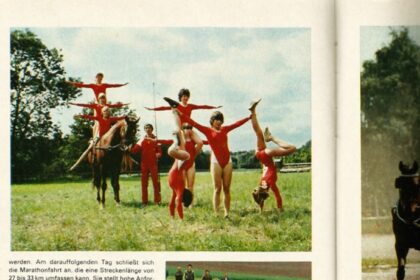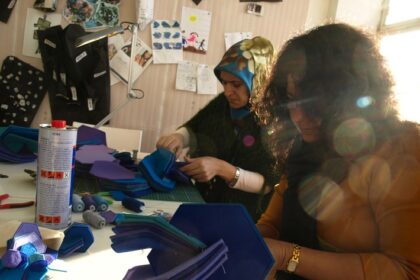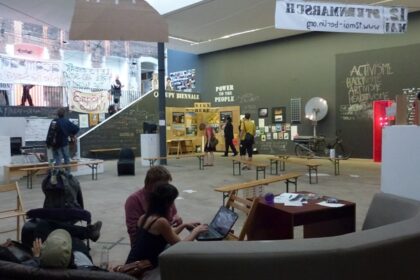An Interview with Tania Bruguera
Immigrant Movement International: Five Years and Counting
Alex Kershaw
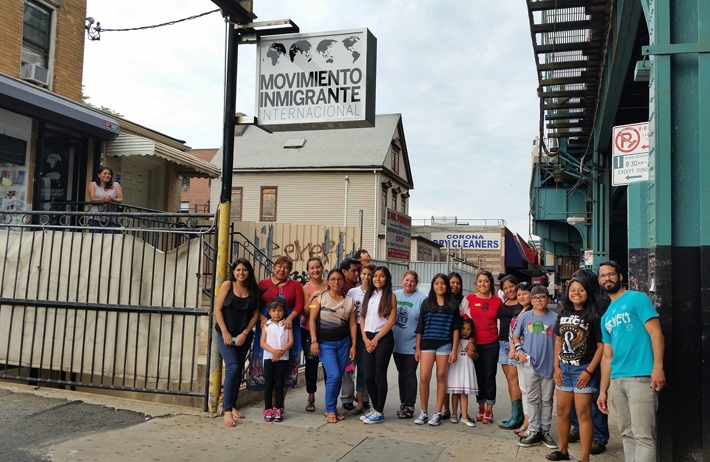
FIELD Journal caught up with Tania Bruguera to discuss Immigrant Movement International (IMI)—an organisation, socio-political movement and art project instigated by Bruguera. While IMI’s mission has evolved over the years, their focus has always been to increase the visibility of immigrants while providing greater access to political power and social recognition for some of the world’s most vulnerable citizens. The project was launched back in 2010 out of a building in the Corona neighbourhood of Queens, New York, where IMI established a community centre with support from the Queens Museum and Creative Time. Over the years IMI has expanded by establishing affiliations and collective actions in other countries, such as Mexico, United Kingdom, Holland, Sweden, and Israel. From their Corona headquarters IMI has engaged in educational programing, symposiums, health and legal services, and workshops. Through this IMI has aggregated a constituency of members that are predominantly Latin American, mainly from Mexico and Ecuador, as well as a significant proportion from the Caribbean and China.
Activist in orientation, IMI has set out to raise public awareness of issues pertinent to immigrants through different zones of contact. These have included social service organizations, state and federal politics, local government, the art world, legal and judicial entities, and the media. In this process IMI has borrowed and adapted various methodologies from these fields in an attempt to solidify their desire to become a social movement.
One of IMI’s steadfast theoretical models has been the testing of Arte Útil (which roughly translates as “useful art” in English). As the name suggests, Arte Útil is a platform, an address and a means for locating new uses for art in society. It seeks to provide beneficial, timely and relevant solutions for those involved with its projects. In terms of aesthetics, its aim is to recast the viewer as a user, while individual artistic authorship is swapped out in preference of the potential for its participants to expropriate the work and make it their own. In these ways Arte Útil is more about working with reality rather than simply representing reality.
For IMI, Arte Útil is practiced in the services and advice it offers to immigrants. At times it has combined political action and illegality, as a means of challenging the law and what those in power define as legal. IMI has identified usefulness in terms of its potential to make progress on immigrant issues, and in its address, it has called on the viewer as a citizen who is asked to act politically. In this way politics becomes not merely the subject matter of the work but its material. However, the world IMI seeks to transform is also one of its greatest challenges. In trying to reimagine and then recast what has been bracketed as “impossible”, Arte Útil embodies a utopian imaginary grounded in real world activity.
Central to what is at stake in a project like IMI is the difficulty in coordinating diverse individual desires with universal demands, and as a social movement, the challenge in generating solidarity through the recognition of difference. How is Bruguera’s voice positioned in relation to the voices of the project’s co-authors? How does the rhetoric of Arte Útil play out when tested by real world circumstances, where the ethics at stake present both opportunities and the potential for situations of inertia, or even worse, produce a backlash that works to dissolve or regulate the very practical demands for rights that are being asked for?
As an example of socially engaged practice inhabiting slippery spaces between art, cultural criticism, socio-political activism, and collaboration, IMI has agitated the persistent binary within art criticism between aesthetic integrity and social function. Given the project’s long-term nature and its sometimes ambivalent attitude toward the traditional framings of the museum, IMI also raises questions about the suitability of art criticism’s most cherished procedures for passing judgment. In the interview that follows, Tania Bruguera addresses some of these issues and questions and gives us a clear picture of the specific ecology of IMI by reflecting on the project five years since it began.
AK: Tania, what is happening right now with IMI? What has changed recently and what remains of what it was?
TB: At IMI we are developing two main changes started last year, marking the arrival of Immigrant Movement International’s maturity as a socially engaged project. First, was our decision to make IMI as a whole, independent from its project in Corona, Queens. Second, to create a community council that would take over the role Immigrant Movement Corona (IMC) was playing as the headquarters for the decision-making process.
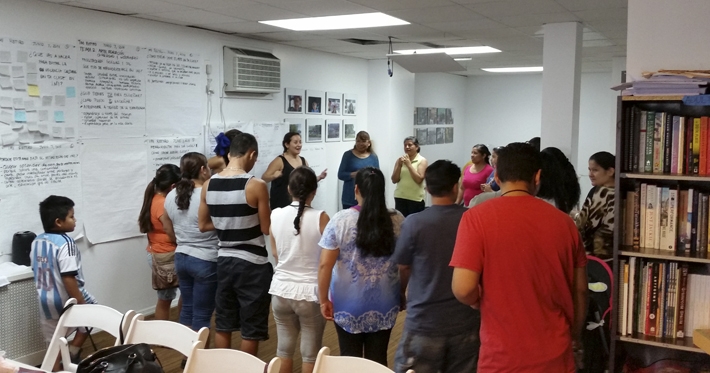
In terms of the first change, transforming IMC from the headquarters of IMI to one of its cells, responds to the idea that immigrant issues can only be analyzed and worked on simultaneously at a local and at an international level. The ideal is to work toward creating a network where immigrants can share their political, social, and human circumstances. This is necessary since immigrants have become the alternative transnational class in what seems to be the creation of a global citizen, an identity that at the moment comprises of and is associated with the rich and the privileged. This is why IMI has accepted invitations to visit other immigrant projects and to try to establish other cells, as well as collaborating with other immigrant groups in Holland, Mexico, Sweden, and Israel. On the other hand, IMC has kept a certain autonomy to enable the possibility for creating public events without putting the community at risk.
Our second change was the resolution to create a community council to take over IMC’s role as the headquarters. This is now fully implemented. The project is workshop-based and we have created a system in which people coming to the project can not only be part of the workshops but also propose one, which they can then lead after making the appropriate preparations. This is how we created the first leaders in the project. Since the second year of the project we established a meeting every three months where all the workshop teachers meet to present what they have done and discuss issues ranging from administration to the project’s identity and to what they envision for IMI. We called these the leaders’ meetings. In these meetings we started making collective decisions about the project. While some leaders taught for limited amounts of time, others have continued their workshops or proposed new ones, which means they have been involved in all aspects of the program for a long time now. Either way, all have influenced what IMC has become.
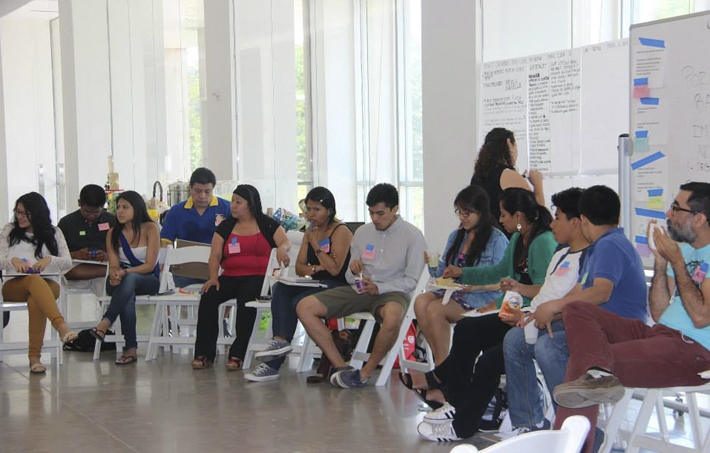
You had asked about what has remained the same. Well, the project has kept its relationship with the Queens Museum, not only as a fiscal sponsor and supporter but also as a consultant. Now that Tom Finkelpearl has gone on to other public functions, we were approached by Laura Raicovich, the museum’s new director. We met Laura who shared her interest in keeping the collaboration with the project. We have also kept our relationship with Creative Time, though on a smaller scale. I’m proud of this because one of my goals was that institutions understand the need to have a long-term relationship with projects like this one. We are also still located in the same place and our presence has grown in the community. Although, for me, more important than numbers is the way in which the community has taken over the project. Now the council is in full control of the project, which I’m proud of.
AK: Tania, in terms of these most recent changes it seems like you are saying that IMC is simultaneously becoming more independent as well as undergoing an incorporation into IMI. How do you see IMI developing into the future? What kinds of things do you feel are necessary for the project to keep-on-keeping-on, so to speak?
TB: Well, growing from the leaders’ meeting, I wanted to formalize the decision-making process by having the project fully run by the community. In order to do that we needed two things. First, we needed to establish the ecology of the place we wanted, while allowing it to guide the final goal of the project and its subsequent ethics and behaviors. Second, we needed to have specific training for those who wanted to be part of this process, so by the summer of the third year we established a project that we called “la escuelita”. This was a series of classes divided into two big groups—art (including: socially engaged, public sphere, Arte Útil and political practices) and activism. This activist preparation included visits to other public art projects in each area like El Puente, Gramsci Monument and Between the Door and the Street. The training process lasted six months and the Queens Museum provided some funds to pay those attending, since they were day-long sessions on a weekly basis. At the end of the first “escuelita” the community council was created. It was instigated by those who attended the training process and who wanted to be a more active part by making a longer-term commitment to the project. We created a consensus system and progressed from talking about empowering the community to actually giving them power over the project. The first council was for a period of one year, a sort of transitory “try out” council, after which its members could decide if they wanted to remain or to leave. Now we have a fully functioning community council and we are going to do “la escuelita” again so there can be a continuous system for building leadership. Hopefully this will ensure that the project evolves with the ideas of each new council member. We have to keep a stable and at the same time renewable energy.
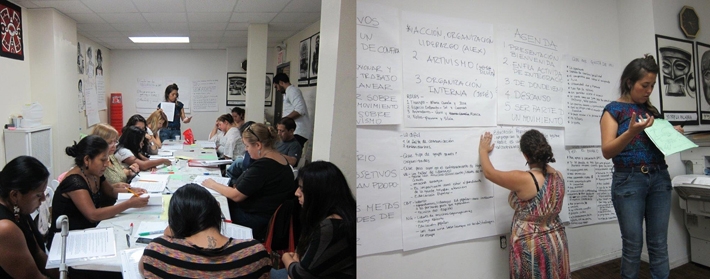
In addition, at IMC we continue to be focused on Arte Útil and are inviting contemporary artists to join the project. Now the biggest challenge for the project is to find creative economic solutions for its sustainability—the rest is there. So we need ways to work towards the last goal, which involves working on economic models in order to achieve sustainability. Another thing that has also come up since our first public event, and I think we could focus on more in the future, is the use of Arte Útil in the project. I think that IMC could become an excellent and natural place to group people practicing Arte Útil on immigrant issues.
AK: It seems to me that one of the long-term goals of the project would be for IMI to have an ongoing life that is maintained by the participants separate or in addition to your own involvement. Even apart from practical considerations such as funding and staffing, this seems like such a difficult task to achieve—especially for a work that is in a large part forged through your own intellectual contributions and physical labor.
TB: All long-term projects inevitably change over time; they need readjustments in order to intervene in both the social sphere and the learned social behavior they confront as a means of arriving at their desired social or political goal. There is an ongoing negotiation between what is established and what you want to change. Long-term projects are educational processes and as knowledge evolves so does the project. These projects are about creating an ecology that embodies the desired change, where people can experiment with what they want before it is socially established, that is, before it becomes culture.
While you have to have a very clear idea of what you would like to achieve with the result, long-term projects should not have a pre-established form. Long-term projects have an unstable form, a liquid form, so that they can adapt to the complexities they confront and to the outcomes of collective authorship. These kinds of projects are not exhibited for a long time, they are shaped by a conscious decision to use art as one agent of social change. They enter inside the social tissue of a place, a group of people or an issue, in order to challenge it. Long-term projects are not passive activities, they are active interventions where the artist is an initiator. They are constantly changing, constantly ongoing—their beauty is the way in which you can perceive how it dialogues with and places a force on social reality. Long-term projects are an ethical journey.
I would say that IMI in Corona has not changed but has evolved and has now entered its political phase. To have arrived at the political phase of the project is something that was my goal from the beginning. I remember the first time a community member said, “We are called a movement so let’s become a movement.” That day I could barely sleep, I was so happy. I felt as if the previous three to four years had been the time period needed to create the conditions for the idea I originally had, not as an imposition from an artist in their community, not as the accomplishment of tasks, but as a natural desire coming from the community. All these years have been about the preparation and the time needed to do the work we wanted to do at IMI. Now we are ready. However, working politically and on politics is always challenging for art institutions.
AK: An exciting component of the IMI project for me is the range of different outcomes the participants might expect from the project and then the kinds of things you personally would like to achieve. Also there seems to be a very interesting tension between the very practical and useful outcomes that are defined collaboratively and perhaps some of the more risky, transformational or even antagonistic possibilities for the project that might be attractive to you as an artist—possibilities that might expose participants to attention that is counterproductive to the aims of the project overall. How do you see the relationship between the artist and the community in projects such as this?
TB: Long-term projects indeed need patience; they are not as compacted, rushed, forced and therefore violent as short-term projects can be. In long-term projects you need to understand the importance of the time needed to prepare the conditions to do the work, especially when you work with vulnerable communities. In these situations you do not want to impose, you do not want to have the come-do-leave artist attitude, because it is not about what you can achieve as an artist but what the community takes with them. Many times I have found out that part of what happens is that in order to do the work with the community, you need to first share knowledge and opportunities with them that exist outside their community. I’m not talking about trying to turn them into who they are not, but to make them reach for things they want but thought were not for them, just because everyone else said so or because they are perceived to be economically unreachable. This is a paralyzing energy you need to work against first. Once the community members understand that social prearrangements can be broken, you can start working in your socially engaged or political art with the community. From here an exchange can be started between what you propose as an artist and what they desire as a community. In that process the spectrum of possibilities as people and as citizens can be expanded. It is important to understand (especially for the people in the arts) that this is a two-way street. Here, when the work is properly done, the artist also expands their own spectrum as a citizen and as a person. For me, working with the community is not a task-oriented activity that either the artist or the community has to accomplish but an ongoing learning process, one that starts with the encounter of two languages—that of art and that of community experience. I do not think the artist needs to infantilize the community or that the artist has to artificially make them pseudo-artists to please the art community. In socially engaged practice, art is not a tool to make art but a tool to be used to make society work differently.
For me, what is exciting is not only the range of different outcomes the co-authors might expect from the project or what I personally want to achieve, but to find a way in which both can be achieved. My idea is to find a common ground where we can meet, where there is not a theirs and mine but an ours, where everyone can fulfill their desires and grow.
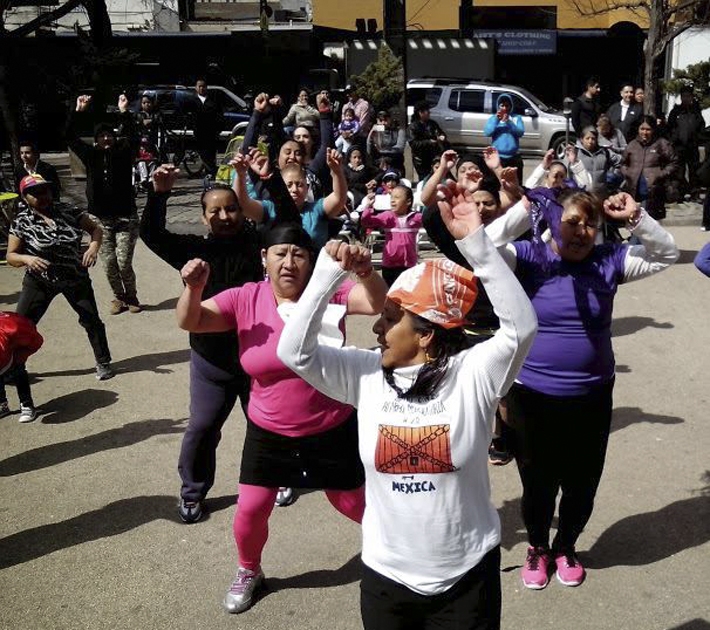
Also when you work with vulnerable communities through art projects there is also the possibility of putting them at risk. That is also why, as I explained before, IMC became part of IMI instead of being an isolated project. However, I have to say that when I told the members of the council the reasons why I felt this separation was important, they said—show us your projects for performances, maybe we want to take the risk, let us decide. So, sometimes you have to understand that the vulnerability of the immigrant community is also its strength.
AK: As a means of developing these close relationships with the community that you speak about, duration, or specifically the brevity of an engagement, has often been used to problematize socially engaged art practices. Should longevity be a goal for a project such as this? Is longevity even desirable?
TB: I do not think that longevity should be a goal in itself, but it is related to how long it takes to change the issue you are addressing. To either do it too quickly or to extend it for longer than needed are both dangerous. If cut short, that is, to leave the project before it has achieved its goal, you could leave the community frustrated. Also this tends to confirm the distrust towards artists who are seen as selfish and uncommitted to social and political causes. In this way the community can become even more discouraged and hopeless than before the project started. Extending the project for longer than necessary is problematic because socially engaged art projects should be done when needed and not as an exercise in form or experimentation with people or to avoid feeling lonely in the studio. However, if the project evolves, if the community sees some benefit and if the artist is still interested to continue the collaboration (or if the community has learned the working methodology and can continue on their own), then by using the built structure and human resources, the project can enter new challenges and start over. But none of this is possible if the community doesn’t trust you—trust takes time and concrete actions of solidarity. Trust comes when the artist works not with but for the community, when they work for the people in the community’s benefit and not for themselves.
You ask about longevity, but I would change that word to commitment. It is not about the length of time or about durability or about preservation of the project. Rather it is about the time that it takes to build and change something in a community. In my experience this is only achieved if the community not only feels represented in the project, but if they feel the project responds to their needs and if the project is useful to them. When you work for a group of people who are not familiar with contemporary art, Arte Útil is an excellent resource.
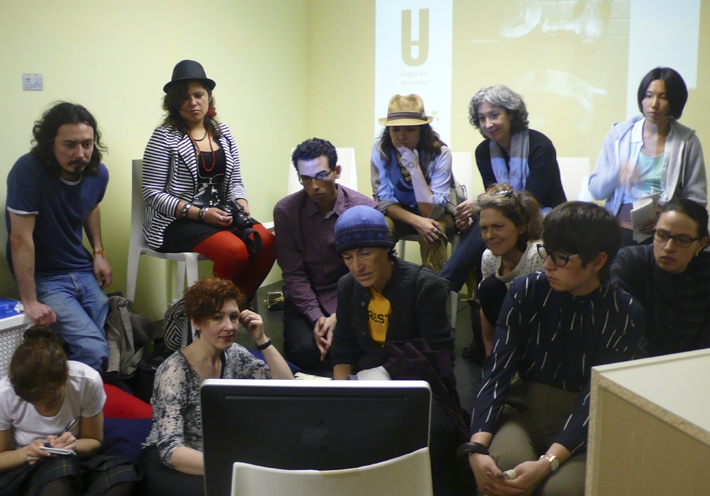
Arte Útil provides an entry point to contemporary art that guarantees attention and interest from an audience generally disengaged and uninterested in contemporary art, or art for that matter. Seeing art as a tool is not the same as instrumentalizing art; it is a way to use all the knowledge you have on how to work with the symbolic, the representational and the imagined to handle a different social proposal. Arte Útil is not used to make society work better but for society to work differently. Arte Útil doesn’t represent—it presents, it proposes and it implements.
In long-term projects I no longer consider concepts like audience or participants, but members, co-authors and friends. Friends may seem an inadequate word but in my experience with the long-term projects Cátedra Arte de Conducta and IMI the moment when you know the project has succeeded is when the people involved in it care as much as you do for it. They make it theirs and defend it because the project has become part of their life. It is a success when you are no longer seen by the community as an artist doing an art project but as a friend they can count on to work towards the same political or social aims. Long–term projects create ecologies where people can live under a different political regime.
In order for such projects to happen and to catch the desire of the community to be part of it, you also need to work with what I call Political-Timing Specific, working with what is currently happening politically around the issue you want to achieve. From the perspective of art, Political-Timing Specific is the awareness that the political conditions can influence an artwork or that they have actually given birth to the need to do the work—the raison d’être of the work. It is as if, for a site-specific practice, you incorporate the political elements that determine and shape the artwork, its impact or its meaning. I use timing in the concept because a work done in this manner would develop and have the form it takes as a result of specific political circumstances. In Political-Timing Specific the project’s aesthetic decisions are taken after political decisions. Working in a Political-Timing Specific manner is to work in an active way, it is to try to change things and not only to approach issues a posteriori, as comments or as lamentations. It is to abandon the position of the victim and to intervene—to be part of what is being politically built.
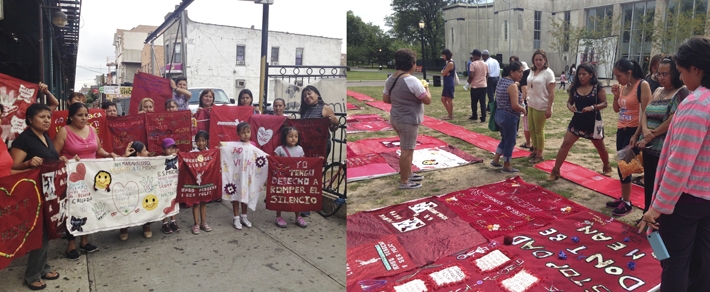
AK: Tania, you have spoken about the beauty of usefulness, as opposed the usefulness of beauty. The question of whether we judge a project through the category of art or whether we judge it through another category like political activism seems to me to be a somewhat unhelpful question in understanding and evaluating the work. I guess the challenge seems to be to find a different model for talking about the work. What kinds of critical models do you think might be useful for evaluating a project like IMI?
TB: I always think that one problematic issue in critique of social practice is that the project’s voice is always that of the artist, as if the artist had agreed to handle some control of the work but not of the narrative created around it. I think that critiques of these projects should have the same multi-voice that the project itself has. There is a common mistrust among art critics of non-art-initiated people’s ability to evaluate art. However, in this kind of project this does not apply because the people from the community are the experts and shouldn’t be seen as mere quotes to give some “color” or legitimacy to the text. They are its co-authors. Also, to have some coherent critique to these kinds of projects one should have a text co-authored by an art critic or art historian and an expert from the field the work is addressing, whether they be a community organizer, a politician, or an economist, etc. This is because long-term projects are the encounter of one or more disciplines (art and pedagogy, art and community organizing, art and economy, art and design, etc.) and can only be adequately represented in a holistic manner. One art critical category cannot properly evaluate all the complexities the projects have. Also, due to the length and the constant natural evolution of the project and its own rhythms, a singular traditional critique cannot do justice to the project. The idea that a critique is a final evaluation of a long-term project can be a very harmful approach, because what is still under construction is evaluated as the final result. It would be best for the critical approach to assume the temporality of what was witnessed or what was thought in relationship with the things to come. Maybe in long-term projects there is no final result until the project is closed. I think criticism of long-term projects needs to clearly state that it is about a specific moment in its evolution.
In terms of criticism I have also been a bit unsatisfied with the constant search for a model of the artist that is not appropriate for socially engaged art. People look for the authorial artist type, but in these kinds of projects artists are initiators. For socially engaged art you need another type, another model of the artist, one where the ethics of the practice is incorporated into what they naturally are. Art critics and art historians need to understand that traditional categories of art and traditional ways of analysing them will not do justice to socially engaged art, political art or Arte Útil practices. These practices are like a branch becoming more independent each day from what we have seen art doing. They come with a new way to comprehend the use of art as well as a new way to understand old concepts like audience and participation. These types of practices open a new regime of the symbolic.
Tania Bruguera is an interdisciplinary artist working primarily in behavior art, performance, installation, and video. She has been a participant in Documenta 11 (Germany) as well as in several biennales such as Venice (Italy), Johannesburg (South Africa), Sao Paolo (Brazil), Shanghai (China), Havana (Cuba), and Site Santa Fe (United States.) She has lectured extensively internationally among others at the New School in New York, the School of the Art Institute in Chicago, the Royal College of Art in London and the Museum of Modern Art in New York. In 1998 she was selected as a Guggenheim fellow (United States). In 2000 she received the Prince Claus Prize (The Netherlands). She received her MFAs from the School of the Art Institute of Chicago (United States) and Instituto Superior de Arte (Cuba). Her BFA is from Escuela de Arte San Alejandro (Havana). She currently lives and works between New York and Havana.
Alex Kershaw is an artist and writer currently working on his PhD at the Visual Arts Department, University of California San Diego.







